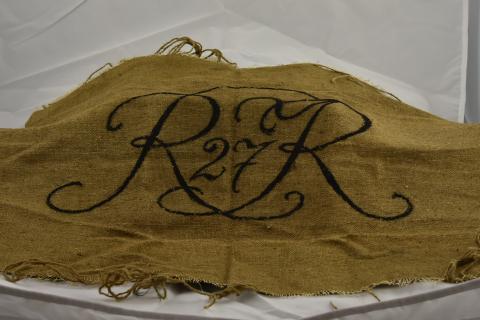This is a 17x24" stitched brown cloth wall covering from a German trench dugout. The front of the covering has the lettering "R.R. 27" stitched into it with black stitching. The edges of the covering are heavily frayed, particularly at the top and bottom. There are several clumps of large strands of fabric that have broken free of the stitching. This makes the piece very vulnerable to continued wear and tear if improperly handled. Wall coverings of this sort were often used as decorations in German trench dugouts during the First World War. They were cheap, easy to make forms of decoration that could provide some small sense of homeliness and comfort in the crowded and dangerous trench complexes. This particular wall covering is stitched with the regimental designation to which it belonged. Dugouts in the First World War were a strategic fortification built into and under the sides of trenches in order to provide living space and shelter for the soldiers on and off duty. British and French dugouts were often very rudimentary and reflective of the poor quality of many Allied trenches during the war. German trenches, on the other hand, were known for being of considerably higher quality, both in overall construction and utility. Many German dugouts from later in the war consisted of large concrete bunkers which could provide increased protection from enemy artillery bombardment. Because of the rigorous nature of trench warfare, however, these dugouts required the men living in them to routinely shore up walls and re-dig portions that caved in. This content can be used with the following resources: SS.6.23: Compare Iowa to World This content can be used to educate students on the changes in art and culture that took place during the First World War and how Iowan art and culture fit into larger trends. By comparing this art piece (German) with art pieces produced in Iowa at the same time, students can learn about the ways in which the war shaped the production of art. For any use other than instructional resources, please check with the organization that owns this item for any copryright restrictions.
2018.002.043 [Tapestry]
Legal Status
Copyright to this resource is held by the Iowa Masonic Library and Museum and has been provided here for educational purposes only, specifically for use in the Iowa Museum Association's "Teaching Iowa History" project. It may not be downloaded, reproduced or distributed in any format without written permission from the Rights Holder. For more information on U.S. and International copyright laws, consult an attorney.

